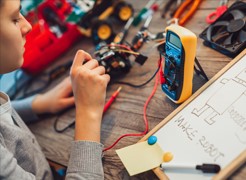Tips for Inspiring Kids to Be the Next Pioneers of Progress

On Introduce a Girl to Engineering Day, schools and individuals are encouraged to engage and introduce girls to engineering. In honor of this worldwide campaign, we asked EBA Engineering, Inc.’s (EBA) employees what they do to inspire the children in their lives (of any gender) and encourage their interest in engineering.
Key findings from DiscoverE’s new report, Despite the Odds, found that both mentorship and hands-on activities help girls develop an interest in engineering, build their confidence in their problem-solving skills, and create a STEM identity. So, we asked our employees how they have acted as role models, and what activities they suggest for teaching kids about how engineers change our world for the better.
“A great way to engage your child in the field of engineering is through career discovery workshops, talks with professional engineers, hobbies, and STEM-related educational activities,” said talent acquisition specialist Karen Reddon.
LEGO sets were a popular recommendation for a STEM-related activity. James Sines, environmental department manager, started his children with the bigger DUPLO bricks, then moved to LEGO building sets in the 4- to 5-year-old range.
“My younger son became a huge fan of just creating new things, especially since he inherited bins full of LEGO pieces without many instruction books,” said Sines.
In EBA’s own backyard, near the nation’s capital, we have valuable resources like the National Air and Space Museum of the Smithsonian Institution, KID Museum, and Children’s Science Center to spark a child’s interest in engineering.
When some of his younger relatives became interested in knowing more about his job as an engineer, Ahmad Karami, PE, said one of the first things he did was take them to various museums in Washington, DC, and other locations for them see in person the engineering work that went into airplanes, buildings, bridges, and more.
“I took them to bridge construction sites, tall buildings, dams, and other civil engineering project sites and explained to them how mathematics, computer knowledge, and other skills enable engineering teams to prepare design drawings and documentation and then actually see their designs become reality,” said Karami.
No matter where you live, though, Reddon notes that you will likely find other available resources like enrolling your child into STEM-focused or pre-engineering camps for youth and teens.
For example, the Society of Women Engineers (SWE) has a membership program for girls aged 13 and up designed to help girls imagine their futures.
“Step back and watch them glow STEM,” said Reddon.
“Engineers solve problems,” said senior associate Bob Sebastian. “And often they are able to keep us from getting into problems.”
He suggested encouraging kids to think and dream of ways they might solve the everyday challenges they encounter. For example:
- How do I get my family to vacation at the ocean safely and quickly so I can enjoy the waves and rides sooner?
- How can I ride my bike along the road without getting hit by a car?
- How can I walk safely to the store to buy food and candy, even if it is nighttime?
- How can my air conditioner at home work better?
- How can I get shoes that don’t slip in the rain?
“Help them see that they can be an engineer and help their friends in many ways,” said Sebastian. “They will become their neighborhood’s problem-solvers!”
Even if you don’t have children in your own home, marketing and communications manager Megan Disney notes that “it’s important for all employees in STEM-related fields to be mentors for the next generation.”
Whether it’s visiting a K-12 school, teaching a college class, participating in a bridge-building competition, volunteering as a role model, or other community outreach, we all have a part to play in educating and supporting the future of engineering.
